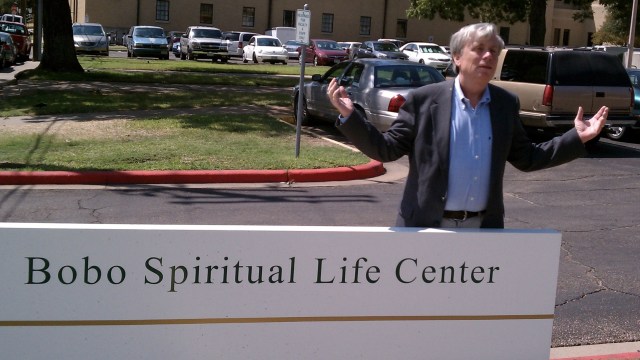Demon Hill. The Most Dramatic Evidence You’ll Ever See About the Limits of Human Rationality.
So you think you’re pretty smart, huh? Intelligent. Able to think critically, to reason, to weigh all the evidence and come up with the right answer and know what’s true. HAH, I say! Such hubris flies in the face of overwhelming evidence that the brain is only the organ with which we think we think. Want a really clear bit of evidence that reason and rationality will only carry us so far?
A video produced by the public radio program Science Friday. takes you inside an art exhibit by Justin Hoeber called ‘Demon Hill’. I promise you will find it fascinating (and probably send the link to your friends). Come back here for a few reflections after you’re done. See you in a few minutes.
A Visit to the Limits of Evidence-Based Reason
Amazing, wasn’t it? A room tilted 20 degrees on one axis and 9 degrees on another, which you can SEE is tilted as you walk into it, assaults the three parts of your balance system – visual, vestibular (ear), and proprioception (touch, which helps your brain figure out where your body is in space) – with violently conflicting information. Conflict between the components of our balance system is what causes motion sickness. (Sorry for not warning you about that possibility before watching the video. It’s way worse for those who dare enter Demon Hill.)
The people in the room KNOW what is true, that the room is tilted. But the visual information simply will not let their brain accept that truth. No matter how their reasoning brain tells them “It’s a TRICK!”, as artist Hoeber says, ‘it’s not an experience you can logic your way out of”. Or as neuroscientist Michael Landy puts it in the video, people are “cognitively impenetrable”. “You can know that what you are perceiving is wrong but you’ll still perceive it that way.”
“Cognitively impenetrable”. “Can’t logic your way out of.” WOW! So long, Cartesian “I Think Therefore I Am” rationality. Hello to the real world of human perception, a system of physical and psychological processes which blends facts and feelings, intellect and instinct, and, when the two conflict, a system which gives the upper hand not to conscious evidence-based reason but to instinctive and subconscious gut reaction.
The same thing that happens to people who enter Demon Hill often happens with risk perception, as we weigh the evidence about whether something seems dangerous. Figuratively, we walk into the room, and a multi-faceted system kicks in. Just like balance, our risk perception system employs several distinct components; one is purposeful conscious reasoning about the facts (think of that as the vision of visitors to Demon Hill), and one is a set of psychological processes and instincts and emotions that help us make quick subconscious judgments about how those facts feel (think of these as the subconscious inputs of the vestibular and proprioception systems of Demon Hill visitors). Just as visual and vestibular information conflicts in visitors to Demon Hill, in risk perception, when reason and evidence clashes with emotion and instinct, no matter how clear and compelling the evidence, we are ‘cognitively impenetrable’ to just the facts, and our brain literally denies that evidence if it conflicts with how our instincts – the subconscious part of the risk perception system that is beyond our control – make that evidence feel.
Examples are everywhere.
In the Demon Hill room of our risk perceptions, there are the facts that our conscious brain may be aware of, and there are all the other inputs into the risk perception system that make those facts feel the way they do. And in the end, when those inputs conflict, as Flora Lichtman said as she narrated the Science Friday video, “our experience of the world depends not on what is true, but what we perceive to be true”.
But here’s the problem. When you walk into Demon Hill and the inputs of your balance system conflict, maybe you get nauseous or dizzy. But when you enter the process of risk perception and those inputs conflict, while you don’t get sick to your stomach, you may end up making judgments and decisions that are dangerous. You go with what feels right, and you end up less worried than you ought to be, or more worried than you need to be. When your feelings fly in the face of the facts and you act on what you perceive to be true, despite the evidence, it can be downright dangerous, to you and to the broader community.
So Demon Hill is instructive, a warning, a challenge to those who have naïve faith in the supreme powers of reason. Sorry, we are sometimes ‘cognitively impenetrable’ to evidence that conflicts with our deeper instincts. Sorry, we can’t ‘logic’ our way through life. Perception, informed not just by the facts but our instinctive interpretations of how those facts feel, IS reality…a potentially dangerous reality. And the sooner we admit the Demon Hill limits of our risk perception system, the sooner we can start to mitigate the risks that system sometimes creates.





